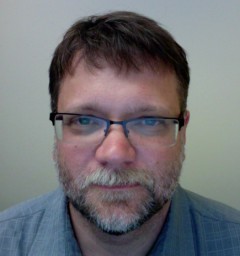
Carroll, David

Educational Background
B.S., Microbiology Auburn University 1988
M.S., Zoology Auburn University 1991
Ph.D., Biomedical Science University of Connecticut 1996
Professional Experience
Director of Graduate Programs in Biological Sciences, Florida Institute of Technology, Melbourne, FL. 2010 - 2018
Associate Professor, Department of Biological Sciences, Florida Institute of Technology, Melbourne, FL.
2005 - present
Assistant Professor, Department of Biological Sciences, Florida Institute of Technology, Melbourne, FL.
1999 - 2005
NIH NRSA Postdoctoral Research Fellow with Dr. Kathy Foltz, Department of Molecular, Cellular and Developmental Biology, University of California, Santa Barbara, CA. 1997 - 1999
Associate Editor BMC Developmental Biology
2008 - present
Selected Publications
Bates, L., Wiseman, E., and Carroll, D.J. (2019) Analyzing gene expression in sea star eggs and embryos using bioinformatics. Methods Cell Biol., 150:471-483.
Shuhaibar, L., Carroll, D.J., and Jaffe, L.A. (2018) "Preparing for Fertilization: Intercellular Signals for Oocyte Maturation" in Diversity in Mechanisms of Fertilization. Yasuhiro Iwao, Editor, Zoological Society of Japan.
Wiseman, E., Bates, L., Dubé, A., and Carroll, D.J. (2018) Starfish as a Model System for Analyzing Signal Transduction during Fertilization. Results Probl Cell Differ. 65, 49-67.
Bates, L.S., Wiseman, E., and Carroll, D.J. (2018) “Patiria minita: transcriptome shotgun assembly”, Bioproject PRJNA398668. National Library of Medicine (US), National Center for Biotechnology Information; 2018 Jan.
Carroll, D.J. and Stricker, S.A. (2014) "Developmental Biology of the Sea Urchin and other Marine Invertebrates" in Method in Molecular Biology series. John Walker, Series Editor, Humana Press, Inc., Totowa, NJ.
Cihal S, Carroll DJ. (2014) Biotinylation of oocyte cell surface proteins of the starfish Patiria miniata. Methods Mol Biol. 1128:197-209.
McGinnis, LK, Carroll, DJ, Kinsey, WH (2011) Protein tyrosine kinase signaling during oocyte maturation and fertilization. Mol. Reprod. Dev. 78:831-45.
Stricker, S.A., Carroll, D.J., Tsui, W.L. (2010) Roles of Src Family Kinase signaling and the first cell cycle in the marine protostome worm Cerebratulus. Int. J. Dev. Biol. 54:787-93.
Carroll, D.J. and Wei, H. (2009) Combining Microinjection and Immunoblotting to Analyze MAP Kinase Phosphorylation in Single Starfish Oocytes and Eggs. Methods Mol. Biol. 518, 57 -66.
*Runft, L.R., *D.J. Carroll, *J. Gillett, A.F. Giusti, F.J. ONeill and K.R. Foltz. 2004. Identification of a Starfish Egg PLC gamma that regulates Ca2+ release at fertilization. Dev. Biol. 269 (May 1): 220-236. *These 3 authors contributed equally to the project and manuscript.
Kumano, M., D.J. Carroll, J.R. Denu and K.R. Foltz. 2001. Calcium-mediated inactivation of the MAP kinase pathway in sea urchin eggs at fertilization.
Dev. Biol. 236:244-257.
Carroll, D.J., D.T. Albay, K. Hoang, F.J. ONeill, M. Kumano and K.R. Foltz. 2000. The relationship between calcium, MAP kinase, and the initiation of DNA synthesis in the sea urchin egg at fertilization. Dev. Biol. 217:179-191.
Research
Using a combination of biochemistry, molecular biology and live cell microscopy, we have discovered that PLCg is required for the initiation of the calcium increase during fertilization in starfish and sea urchin eggs. In collaboration with Dr. Kathy Foltz of the University of California at Santa Barbara and Dr. Laurinda Jaffe of the University of Connecticut Health Center, we have cloned a starfish PLCg cDNA from an arrayed oocyte cDNA library. We are currently using this clone as a tool to look for proteins that interact with PLCg in a fertilization-specific manner. We have determined that there are a suite of tyrosine-phosphorylated proteins, some from the sperm and some from the egg, that bind to PLCg only after fertilization. The identification of these proteins is a major goal of the laboratory in the coming years. Two graduate students from the laboratory (Leia Shuhaibar and Lu Zhong) have also developed a method for the visualization of changes in an enzyme called Mitogen-activated Protein Kinase (MAPK) using single cells. This allows us to gain a better understanding of the regulation of this enzyme during oocyte maturation and fertilization. Ph.D. students Lauren Bates and Emily Wiseman have developed a new starfish egg transcriptome which will allow us to identify and clone any proteins identified in our screens for novel signaling molecules at fertilization. The transcriptome can be accessed here: https://www.ncbi.nlm.nih.gov/bioproject/?term=PRJNA398668
Our lab is interested in the molecular mechanisms that regulate oocyte maturation and fertilization. Sperm-egg fusion initiates a transient increase in the concentration of cytoplasmic calcium in the egg. This increase is a fundamental process that occurs in the eggs of all the organisms that have been studied and it is critical for activating the egg to begin development. Incredibly, the molecular mechanism that links the sperm-egg interaction to the initiation of this calcium increase is only now beginning to be understood.
Our research focuses on the role of a particular enzyme called phospholipase C gamma (PLCg). PLCg is a member of a larger class of cytoplasmic enzymes called phospholipases. These enzymes function to produce two signaling messenger molecules called diacylglycerol and inositol 1,4,5-trisphosphate from membrane phospholipids. They function in many cell types, including nerves, muscles and immune cells.
PI of NIH R15 Award on "Signal Transduction during Fertilization" from 2018 - 2021.
Co-PI with Dr. Munevver Subasi, Dept of Mathematics, for the BioMath Research Experience for Undergraduates (http://research.fit.edu/reu-biomath/) from 2015 - 2018.
Member, Institutional Biosafety Committee
Member, Institutional Radiation Safety Committee


 Give to Florida Tech
Give to Florida Tech